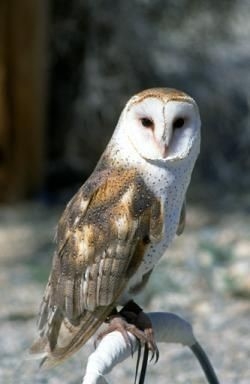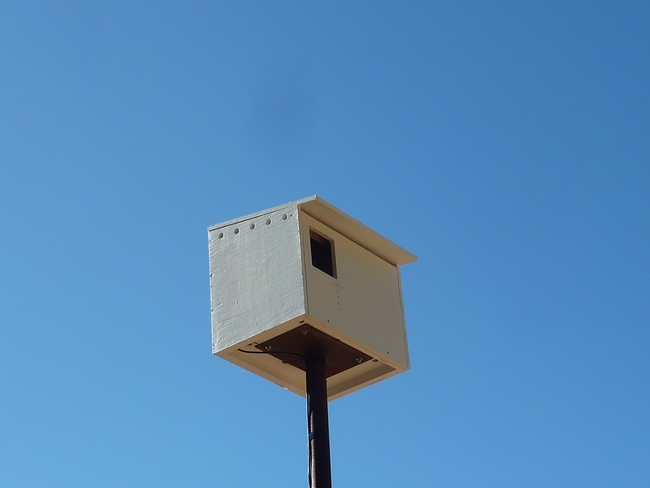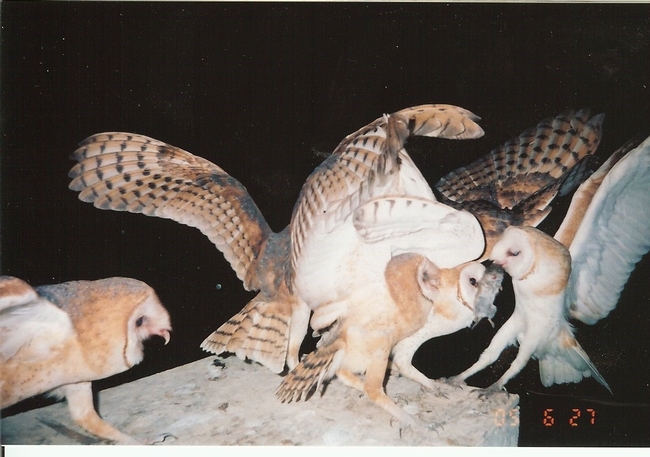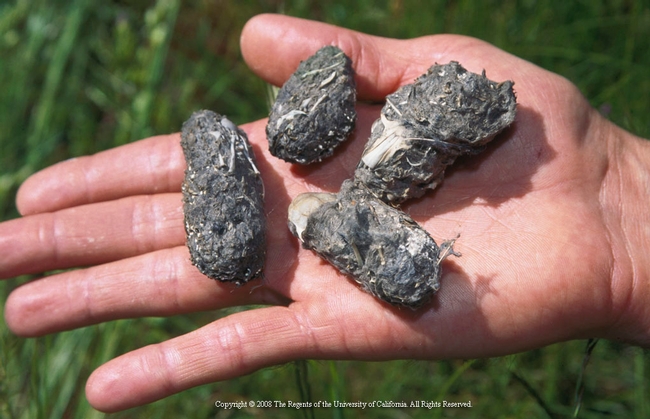Posts Tagged: boxes
Barn owls help clean up rodents naturally
The screech of a barn owl at night may be startling or annoying to some. But others may find their harsh calls satisfying, knowing that barn owls are out, feeding on pesky rodents.
They're fierce hunters with a voracious appetite for mice, voles, gophers, and rats. A family of five barn owls, including two adults and three young will feed on about 1,000 rodents during a season. When they nest twice in a year, that number doubles and you wind up with some good help on rodent control that's safe and free.
So, the next time you hear that eerie, rasping sound at night, don't panic. Instead, think about all the good the owls are doing. Even better, invite a family of barn owls to your property by building a nest box for them and creating a home.
Identifying barn owls. If you're lucky to spot one in an old barn where they're often found (hence their name), they have iconic white heart-shaped faces, white chests, and tan-colored backs with spots. Barn owls are nocturnal and can be recognized by their drawn-out rasping screech. Unlike other owls, they don't hoot. They often shriek when they leave their roost to hunt and make hissing and snapping sounds when startled.
Barn owls have excellent vision and hearing for finding prey in the dark and capturing it with their sharp talons and beaks. They're quiet hunters, flying close to their prey without being heard, due to specialized feathers, making them incredibly good predators. Barn owls are found world-wide and occupy a wide range of habitats, including natural, agricultural, and urban areas, but prefer to hunt in more open areas as opposed to forests. They readily hunt rodent pests in grape vineyards, alfalfa fields, and along levees, making them valuable allies for farmers.
How do you attract barn owls? Barn owls are cavity nesters, including cliffs, trees, and buildings such as barns, so they will readily use nest boxes. Plans for how to build nest boxes can be found in the UC Agriculture and Natural Resources (UC ANR) booklet, Songbird, bat, and owl boxes. This handy guide also shows how to attract insectivorous birds and bats to help control insect pests naturally. Barn owl boxes and plans can be found online or through local sources, such as G. Rohman (photographer). Barn owls begin nesting in February, so now is the time to put up a house before males and females select nest sites. Boxes should be mounted 10 feet off the ground on metal poles to prevent mammal predators from accessing the boxes and feeding on eggs or chicks.
Paint the boxes white to keep them cooler and help prevent weathering and face them northeast. Add some timothy hay for bedding (often sold in small bags in stores for rabbit feed). Wooden nest boxes are generally preferred over plastic ones. Fifty gallon drums can also be used; just remove the top, retaining a lip so the chicks don't fall out, add some hay, and hoist it up on a rafter in a barn and secure it well with a chain. Avoid disturbing nest boxes during the breeding season (February through August), as barn owls will often abandon nests if disturbed while nesting.
Who moves into the nest box? A family of barn owls. Females generally lay four to seven eggs from February to April, which hatch in about 30 days. While they incubate the eggs, the males bring food to the nest. The baby owls fledge in about 10 weeks, but stay around the nest until fall, when they wander off, usually within 30 miles of where they were born. Sometimes a second clutch of eggs is laid in May. Barn owls do not migrate, so tend to stay in an area year-round and will reoccupy a nest box the following year. They generally forage about one to three miles from their roosts. They are only mildly territorial in that they will defend their nests if you get too close. This means that you can put up several nest boxes in an area and expect occupancy from several families. Barn owls generally only live for about two years. Great horned owls are the fiercest predator of adult barn owls (and collisions with cars).
What are they eating? The favored prey of barn owls is rodents, including voles and gophers. Like other owls, they often swallow their prey whole and then undigested bones and fur are coughed up (regurgitated) as owl pellets. These pellets can be dissected and prey readily identified by the skeletons left behind. Farmers appreciate owls and other raptors because they feed on rodents that can damage their crops and irrigation systems (Wildlife Survey).
UC ANR researchers, including Roger Baldwin, UC Cooperative Extension vertebrate pest control specialist, are currently evaluating the economic impact of barn owls for rodent control in agricultural lands. It is important to note that rodents reproduce rapidly so barn owls cannot always keep up with rodent outbreaks and other methods of control might be needed to prevent crop damage (Rodent Control). But, every rodent a barn owl takes is one less we have to deal with!
How about maintenance? Barn owl boxes need to be cared for and cleaned once a year during fall or winter (October to December) as the pellets can quickly fill up a nest box. Doors for accessing the inside of the boxes need to be secured, hinges lubricated, and mounting structures checked during annual inspections. Avoid breathing unhealthy dust when cleaning the house and always make sure no one is home. Although this takes time, the pellets cleaned out might have added value. A Yolo County farmer mentioned he has a buyer for his pellets, which are used for science projects where students dissect them to learn about skeletons and barn owl diets. He read his recent owl pellet invoice noting, “The pellets are graded from small at 10 cents each to premium at 20 cents each and I sold over 100. Barn owls are great!”
Thinking of Becoming a Commercial Beekeeper?
So you're thinking of become a commercial beekeeper and renting your colonies to almond growers. California currently grows some 900,000 acres...
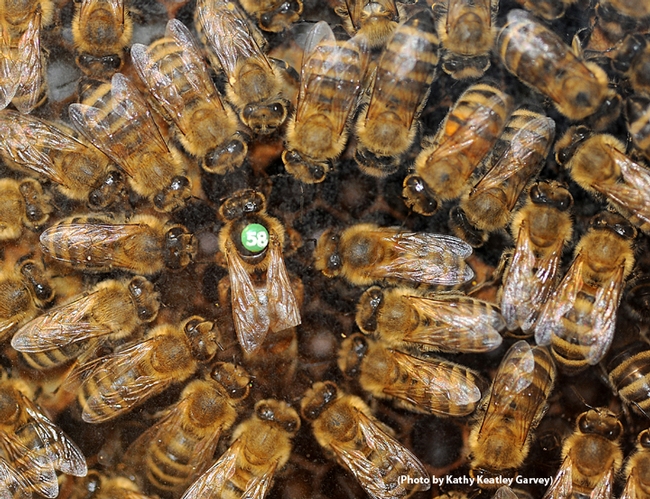
A queen bee and her retinue. (Photo by Kathy Keatley Garvey)

Smoking a hive. (Photo by Kathy Keatley Garvey)
Ducks Vs. Bees
In March of 2012 when we were touring The Bee Collective's Bee Sanctuary near The Domes on the UC Davis campus with beekeeper/manager Derek...

This wood duck box is being used as a bee hive in The Bee Sanctuary on the UC Davis campus. Examining it is Derek Downey who directs The Bee Collective and The Bee Sanctuary. (Photo by Kathy Keatley Garvey)
Succulent Boxes
In 2012, the Solano Master Gardeners held a class to make succulent boxes. We brought succulents from home and planted them in pre-made wooded boxes. The boxes had been constructed by volunteer Master Gardeners (or their husbands) who were gifted with building skills. The boxes were 6x6x3.5 inches, had a hardboard backing and ½ inch wire mesh on top. Everyone attending filled their boxes with soil, shared succulents and inserted them into the small spaces in the wire mesh. The group was loud and excited. It was a fun-filled, sharing, learning experience.
I came home so excited and mentioned to my husband that I wanted to make another succulent box BUT on a grander scale. Being the inventive and frugal person he is, he found a picture frame our neighbor had thrown in the trash, discovered some left over cement board in our garage and a yellowed piece of plastic lathe that was left over from building our patio. With those materials and a few screws, he created a succulent wall planter, 16x30x3 inches. He spray painted it ‘John Deere’ green so it would blend into the garden. It took awhile to fill each small opening in the lathe with the succulent cuttings I had been snipping from our garden. He placed two eye-hooks on each end of the box and hung it from the fence where two eye-bolts had been placed. This system makes rotating the box simple and keeps the soil inside from ‘slumping’. The first of each month, the box is taken down, placed across the top of our wheel barrow and watered thoroughly. We leave it flat for approximately an hour for the water to saturate the soil. Then it is hung in the opposite direction (using the eye-hooks on the opposite end).
This large succulent wall survived the winter with some minor frost damage. I did not cover it or provide protection last winter. This winter I plan to protect it with frost cloth or move the box into the garage. The frost damaged succulents were removed and NOT replaced. The plants not damaged have grown significantly and now cover the empty holes in the lathe.
The box has turned into a traveling planter, being a display item at the Dixon May Fair. When it returned home, it was not placed in the initial hanging spot. It presently hangs against the garden cottage wall next to the covered patio. It makes quite a statement as you walk down the brick pathway to enter the backyard garden.

Sorry, picture a little blurry, but it's the start of the succulent box. (photos by Sharon Rico)

Succulents maturing in the box.

The final product is pretty nice.
A Little of This and a Lot of That
Today was quite interesting! I’m trying to do something (anything) in the back yard and the crows continue to caw: nothing like having your yard used as flight training school. Somewhere in the high grass near the shed is a “baby” crow who is not too sure about how these feathery things work. The term “baby” is not too descriptive – he/she is larger than the size a dove but young nevertheless!
I almost stepped on junior(ess?) yesterday while checking out the progress or lack of it I’m making in the side yard. (After 2 weeks previously of hacking and whacking at the rambler roses there, I’ve relocated a large raised bed with nothing in it. Well, almost nothing – “Bobbie James” decided to toss a runner in there and now it sits – denuded, but lethal all the same. Can’t dig it up – did I mention that I’ve been hung up at home for 2
months with a badly sprained knee (a knee, you say, surely you mean an ankle); nah, a knee and without 2 decently working knees, one simply doesn’t dig – trust me, brace and all—it doesn’t work! So I do what any other dedicated gardener does: I just stood there and glowered at it! The bush didn’t take the hint – it wants to bloom. Giving it another very short haircut, and it looks soo much better already.
But I did find a project: making 13 boxes for the upcoming Succulent Box planting class. Bruce, the woodworker, cut all the pieces of wood to size and I put them together! Ok, so I put them together with a lot of stand-by assistance in the form of advice. Bruce sat in the garage cum workshop (garage, yes right – couldn’t get a car in there with a shoehorn or wax from a candle.
I have found out more about 45 degree angles and how not to cut them than I care to know. When I get back to work and the State Parks Department goes into the box-making business, I’ll be in charge! But, I’ll graciously decline the job. Seriously,
I can now understand why these things are expensive – they are time consuming. But that not all I did...
For a long time now, I’ve wanted to catalogue my books so that I can not only find one when I need it, but also to crack down on duplicates. You know, when you find 2 or 3 of one book but not the one you thought you had and desperately need now!
The whole process only took 4 days – emptying shelves, entering, and replacing. Another time consuming job, but one that’s done and over. I have only 12 duplicate copies of
volumes now to get rid of. I’ll be sending Jennifer a list in case somebody needs additional books for their gardening libraries. It was actually rather nice to go through the books and see which were my mother’s first and which she bought for me.
Well, I’ll quit for now. My this and that ideas are coming to the fore and I need to write myself a note for future ventures outside. I sure hope the crow learns to fly in a hurry so that I can go out to the back without the constant cawing and dive bombing from mom and dad. Heck, I’ll teach him/her how to fly myself!


